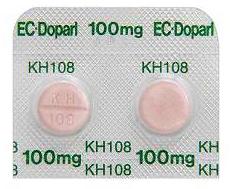英文药名: EC-DOPARL Tablets(Levodopa/Benserazide Hydrochloride)
中文药名: 左旋多巴/盐酸苄丝肼复方片
生产厂家: 协和发酵麒麟
イーシー・ドパール配合錠
类别名称
抗帕金森剂
欧文商標名
EC-DOPARL Tablets
○左旋多巴
一般名
Levodopa
化学名
3-Hydroxy-L-tyrosine
略名
L-DOPA
分子式
C9H11NO4=197.19
化学構造式
性状
在白色或微白色晶体或与灰色彩结晶粉末,没有异味。
可溶性
易溶于甲酸,微溶于水,并在乙醇中(95)几乎不溶。溶于稀盐酸。
(饱和水溶液的PH值是5.0至6.5)。
熔点
约275℃(分解)
旋光度
[Α]20D-11.5〜-13.0°
(干燥2.5克的1mol后/ L盐酸50毫升100毫米)
分配系数
logP'OCT=-3.4
(测量方法:摇瓶法正辛醇/pH7.4缓冲溶液)
○盐酸苄丝肼
一般名
Benserazide Hydrochloride
化学名
(2RS)-2-Amino-3-hydroxy-N′-(2,3,4-trihydroxybenzyl)propanoylhydrazide monohydrochloride
分子式
C10H15N3O5・HCl=293.70
化学構造式
性状
是一种白色或类白色结晶性粉末。
它是吸湿性的。
光逐渐着色。
可溶性
易溶于水或甲酸,略溶于甲醇,乙醇极微溶于(95),并在乙醚中几乎不溶。
(水性溶液(1→100)的PH值是4.0至5.0)。
熔点
约145℃(分解)
旋光度
的DL-形式,这是不旋光。
分配系数
logP'OCT=-1.9
(测量方法:摇瓶法正辛醇/pH7.4缓冲溶液)
适应病症
帕金森氏病,帕金森氏综合症
用法用量
帕金森氏病,帕金森氏综合症
在左旋多巴未处理例的情况下:
成人:每日分成三次,每次报1至3片,饭后口服给药,每日一次剂量为1至2片,每2至3天,并逐渐增加,31天-作为维持剂量6锁定口服给药。
该剂量可以根据年龄和症状进行调整。
在给药左旋多巴例的情况下:
成人:初始每日剂量切换到左旋多巴量对应于左旋多巴量(这种药物在含有一个片剂左旋多巴100毫克)在施用大约五分之一,在1-3分剂量,饭后口服给药,逐渐增加或逐渐减小,3至6片作为维持剂量的每日剂量口服施用。
该剂量可以根据年龄和症状进行调整。
药效药理
作用机序
本剂左旋多巴迁移入脑,纹状体是锥体外系中心,被转换为多巴胺黑质等代表的操作。另一方面,苄丝肼盐酸盐混合在该药物,而不在推荐剂量要脑,肝,抑制肾,心脏,多巴脱羧酶在小肠等周边,抑制儿茶酚胺生产周并允许增加的过渡量到大脑,以增加血液左旋多巴浓度。
应当指出的是,不像在左旋多巴单一试剂,该试剂是几乎不受维生素B6组合。
包装规格
组合片剂:
[PTP] 100片(10片×10)
[PTP] 500片(10片×50)

制造厂商
协和发酵麒麟有限公司
完整处方资料附件:http://www.info.pmda.go.jp/go/pack/1169100F1052_1_07/
EC-DOPARL Tablets(イーシー・ドパール配合錠)
Brand name : EC-DOPARL Tablets
Active ingredient: Levodopa
Benserazide hydrochloride
Dosage form: pale red tablet, diameter: 9.1 mm, thickness: 3.5 mm
Print on wrapping: KH 108 100mg
Effects of this medicine
The active ingredient of this medicine, levodopa, is transferred to the brain after being absorbed and is converted into dopamine. Benserazide hydrochloride increases blood levodopa concentration and enhances the transfer of levodopa to the brain.
Dopamine deficiency in the brain induces Parkinsonian symptoms such as tremor of limbs and mouth, muscle rigidity, difficulty in walking and amimia.
It replaces deficient dopamine in the brain, and is usually used in the treatment of Parkinson's disease and Parkinsonian syndrome.
Before using this medicine, be sure to tell your doctor and pharmacist
•If you have previously experienced any allergic reactions (itch, rash, etc.) to any medicines.
If you have: angle closure glaucoma.
•If you are pregnant or breastfeeding.
•If you are taking any other medicinal products. (Some medicines may interact to enhance or diminish medicinal effects. Beware of over-the-counter medicines and dietary supplements as well as other prescription medicines.)
Dosing schedule (How to take this medicine)
•Your dosing schedule prescribed by your doctor is <<to be written by a healthcare professional>>
•For patients who are untreated with levodopa: In general, for adults, take 1 to 3 tablets a day as the initial dose at one time or in 2 or 3 divided doses, after meal. The dosage will be increased by 1 or 2 tablets a day every 2 or 3 days, and then take 3 to 6 tablets a day as the maintenance dose.
For patients who are treated with levodopa: In general, for adults, take the equivalent of approx. 1/5 levodopa dose that you are taking (this preparation contains 100 mg of levodopa in a tablet) a day as the initial dose at one time or in 2 or 3 divided doses, after meal. The dosage will be increased or decreased gradually, and then take 3 to 6 tablets a day as the maintenance dose.
The dosage may be adjusted according to the age or symptoms in any case. Strictly follow the instructions.
•If you miss a dose, take a dose as soon as you remember. However, if it is almost time for the next dose, skip the missed dose and follow your regular dosing schedule. You should never take two doses at one time.
•If you accidentally take more than your prescribed dose, consult with your doctor or pharmacist.
•Do not stop taking this medicine unless your doctor instructs you to do so.
Precautions while taking this medicine
•This medicine may cause sudden onset of sleep, somnolence (falling into a half-doze), accommodation disorder and decline in attention and reflex movement without any signs. Avoid driving a car or engaging in dangerous activities.
•In the very rare case, saliva, sputum, oral mucosa, sweat, urine and stool may turn black.
Possible adverse reactions to this medicine
The most commonly reported adverse reactions include involuntary movement, nausea, vomiting, loss of appetite, hallucination, insomnia and lightheadedness. If any of these symptoms occur, consult with your doctor or pharmacist.
The symptoms described below are rarely seen as initial symptoms of the adverse reactions indicated in brackets. If any of these symptoms occur, stop taking this medicine and see your doctor immediately.
•high fever, muscle rigidity, tremor in limbs [neuroleptic malignant syndrome]
•seeing things or hearing sound that do/does not actually exist, dark mood, feeling blue and discouraged, thinking disturbance, cognitive disorder in time, place or surrounding [hallucination, depression, confusion]
•abdominal pain, heartburn, nausea [exacerbation of gastric or duodenal ulcer]
•anemia symptom, jaundice, easy to bleed [hemolytic anemia, thrombocytopenia]
•sudden sleep without any signs, sleepiness, sedation [sudden onset of sleep]
The above symptoms do not describe all the adverse reactions to this medicine. Consult with your doctor or pharmacist if you notice any symptoms of concern other than those listed above.
Storage conditions and other information
•Keep out of the reach of children. Store in the shade, away from heat and moisture.
•Discard the remainder. Do not store them.
•[To family members] Despite an unfavorable social outcome, the following symptoms may appear: repeated gambling, repeated excessive unplanned shopping, and an abnormal rise in sexual desire and appetite, etc. If any of these symptoms are observed, consult with your doctor
Kyowa Hakko Kirin Co.,LtdInternal
Revised: 9/2013
The information on this sheet is based on approvals granted by the Japanese regulatory authority. Approval details may vary by country. Medicines have adverse reactions (risks) as well as efficacies (benefits). It is important to minimize adverse reactions and maximize efficacy. To obtain a better therapeutic response, patients should understand their medication and cooperate with the treatment.



